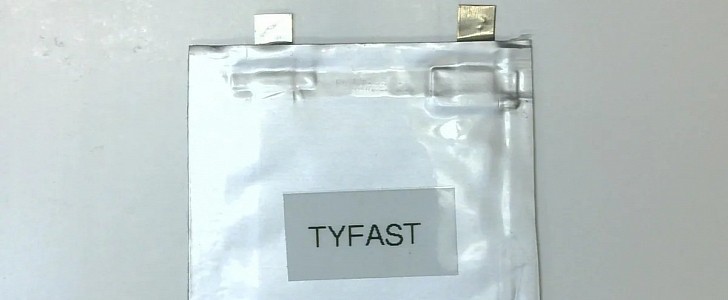Li-Ion battery research concentrates mainly on increasing energy density, but TyFast goes in the opposite direction. The company compromises battery capacity to offer insanely fast charging and a long life cycle.
Studies consistently show that customers want electric vehicles to travel 1,000 miles (1,609 km) on a charge, and that’s why battery companies concentrate on increasing battery capacity and energy density. But just like with mobile phones, battery capacity is not that important when you can top up the battery in minutes. In fact, it’s even better since a smaller battery makes an electric vehicle more efficient and nimble.
TyFast’s strategy follows this path, trading some energy density to achieve a very fast charging and a virtually unlimited lifecycle. The company claims its vanadium anode battery can charge 20 times faster than average Li-ion batteries and last 20 times longer. The goal is to charge fully in as little as three minutes and 20,000 charging cycles. As for the energy density compromise, it is not that big. According to TyFast, its battery still offers an 80 to 90 percent energy density compared to present-day batteries.
The secret is a new lithium vanadium oxide (LVO) anode to replace the typical graphite anode used in Li-Ion batteries. The vanadium anode allows for a much faster ion flow, 10 times faster, to be precise. The LVO anode also has the advantage that it contracts and expands less than graphite when charging and discharging. This translates into less mechanical damage to the anode, which helps with the longer battery life.
“Our high-level focus is 20 times faster charging and 20 times longer life than today’s lithium batteries,” said GJ la O’, CEO and co-founder of TyFast, to ieee.org. “We’re saying we’ll deliver the same runtime as the previous-generation device but charge really, really fast such that you forget about the size and energy density.”
The downside is that LVO holds fewer ions than graphite by weight. It is also more expensive, almost twice as expensive as today’s graphite anodes. But since LVO has a much longer lifecycle, it can compensate for its higher costs. The prototype cells that TyFast has built proved they can last for over 2,000 charge cycles and charge in under 15 minutes. By the end of the year, the company plans to reach 20,000 cycles and under three-minute charging.
The main target for these batteries is not electric vehicles but always-on, high-utilization devices such as autonomous warehouses or delivery robots that need to work 24/7. They could benefit from faster charging, allowing them to work more with just a short fast-charging stop. Or they could use a much smaller battery, which means they could carry more weight, increasing productivity. And because it can be replenished in minutes, it doesn’t matter if its capacity is smaller.
TyFast’s strategy follows this path, trading some energy density to achieve a very fast charging and a virtually unlimited lifecycle. The company claims its vanadium anode battery can charge 20 times faster than average Li-ion batteries and last 20 times longer. The goal is to charge fully in as little as three minutes and 20,000 charging cycles. As for the energy density compromise, it is not that big. According to TyFast, its battery still offers an 80 to 90 percent energy density compared to present-day batteries.
The secret is a new lithium vanadium oxide (LVO) anode to replace the typical graphite anode used in Li-Ion batteries. The vanadium anode allows for a much faster ion flow, 10 times faster, to be precise. The LVO anode also has the advantage that it contracts and expands less than graphite when charging and discharging. This translates into less mechanical damage to the anode, which helps with the longer battery life.
“Our high-level focus is 20 times faster charging and 20 times longer life than today’s lithium batteries,” said GJ la O’, CEO and co-founder of TyFast, to ieee.org. “We’re saying we’ll deliver the same runtime as the previous-generation device but charge really, really fast such that you forget about the size and energy density.”
The downside is that LVO holds fewer ions than graphite by weight. It is also more expensive, almost twice as expensive as today’s graphite anodes. But since LVO has a much longer lifecycle, it can compensate for its higher costs. The prototype cells that TyFast has built proved they can last for over 2,000 charge cycles and charge in under 15 minutes. By the end of the year, the company plans to reach 20,000 cycles and under three-minute charging.
The main target for these batteries is not electric vehicles but always-on, high-utilization devices such as autonomous warehouses or delivery robots that need to work 24/7. They could benefit from faster charging, allowing them to work more with just a short fast-charging stop. Or they could use a much smaller battery, which means they could carry more weight, increasing productivity. And because it can be replenished in minutes, it doesn’t matter if its capacity is smaller.







